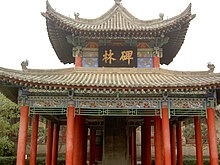Guozijian
| Guozijian | |||||||||||||||||
|---|---|---|---|---|---|---|---|---|---|---|---|---|---|---|---|---|---|
| Chinese name | |||||||||||||||||
| Traditional Chinese | 國子監 | ||||||||||||||||
| Simplified Chinese | 国子监 | ||||||||||||||||
| |||||||||||||||||
| Vietnamese name | |||||||||||||||||
| Vietnamese alphabet | Quốc tử giám | ||||||||||||||||
| Chữ Hán | 國子監 | ||||||||||||||||
| Korean name | |||||||||||||||||
| Hangul | 국자감 | ||||||||||||||||
| Hanja | 國子監 | ||||||||||||||||
| |||||||||||||||||
| Manchu name | |||||||||||||||||
| Manchu script | ᡤᡠᡵᡠᠨ ᡳ ᠵᡠᠰᡝ ᠪᡝ ᡥᡡᠸᠠᡧᠠᠪᡠᡵᡝ ᠶᠠᠮᡠᠨ | ||||||||||||||||
| Möllendorff | gurun-i juse be hūwašabure yamun | ||||||||||||||||




The Guozijian,[1] sometimes translated as the Imperial College, Imperial Academy, Imperial University, National Academy, or National University,[2] was the national central institution of higher learning in Chinese dynasties after the Sui dynasty. It was the highest institution of academic research and learning in China's traditional educational system, with the function of administration of education.
History[edit]
Formerly it was called the Taixue (lit. 'Imperial University'). The Taixue for Gongsheng (tribute students) from the populace was part of the Guozijian, along with Guozixue for noble students. The central schools of the Taixue were established as far back as 3 CE, when a standard nationwide school system was established and funded during the reign of Emperor Ping of Han.[3] The institution was known as the Guozijian beginning in the Sui dynasty. During the Ming dynasty, the Hongwu Emperor promoted the study of law, math, calligraphy, equestrianism, and archery at the Guozijian.[4]
In 1905, the Guozijian was shut down. During the 1898 reform of the Qing dynasty, the education and administrational functions of the Guozijian were mainly replaced by the Imperial Capital University (also translated as Imperial University of Peking), which later became the modern Peking University.
Locations[edit]
Guozijian were located in the national capital of each Chinese dynasty, such as Chang'an, Luoyang, Kaifeng, and Hangzhou. In early years of the Ming, the Guozijian was in Nanjing. Afterwards, the Ming had two capitals, so there were two Guozijian: one in Nanjing (which later became Nanjing University) and one in Beijing. During the Qing dynasty, the Guozijian was in Beijing.
The Beijing Guozijian, located on Guozijian Street in the Dongcheng District, was the imperial college during the Yuan, Ming, and Qing dynasties; most of the current buildings were built during the Ming dynasty.[5] It was the last Guozijian in China and the predecessor of Peking University.
Vietnam[edit]


In Vietnam, a year after the first Confucian examinations established by Lý Nhân Tông (李仁宗), the Guozijian (Vietnamese: Quốc tử giám, chữ Hán: 國子監) was built in 1076 on the site of the Temple of Literature.[6] It was Vietnam's first university, it lasted from 1076 to 1779. In 1802, the Nguyễn dynasty founded the Huế capital where they established a new imperial academy in the new capital. Several notable rectors of the Quốc tử giám in Hanoi were Chu Văn An, Nguyễn Phi Khanh, and Vũ Miên.
See also[edit]
- Academies (Shuyuan)
- Ancient higher-learning institutions
- Peking University
- Nanjing University
- Yuelu Academy (later become Hunan University)
References[edit]
Citations[edit]
- ^ Yuan, 194.
- ^ Frederick W. Mote; Denis Twitchett (26 February 1988). The Cambridge History of China: Volume 7, The Ming Dynasty, 1368-1644. Cambridge University Press. pp. 131–. ISBN 978-0-521-24332-2.
- ^ Yuan, 193.
- ^ Frederick W. Mote; Denis Twitchett (26 February 1988). The Cambridge History of China: Volume 7, The Ming Dynasty, 1368-1644. Cambridge University Press. pp. 122–. ISBN 978-0-521-24332-2.
- ^ "Guozijian". James P. Geiss Foundation. Archived from the original on 2017-08-13. Retrieved 2008-08-07.
- ^ Ngô, Tự Lập (2016). "Higher education internationalization in Vietnam: unintended socio-political impacts of joint programs seen as special free academic zones" (PDF).
Sources[edit]
- Chang, Che-chia. "The Qing Imperial Academy of Medicine: Its institutions and the physicians shaped by them." East Asian Science, Technology, and Medicine 41.1 (2015): 63–92. online
- Sivin, Nathan. "Science and Medicine in Imperial China--the state of the field." Journal of Asian Studies (1988): 41–90. online
- Yuan, Zheng. "Local Government Schools in Sung China: A Reassessment," History of Education Quarterly (Volume 34, Number 2; Summer 1994): 193–213.
